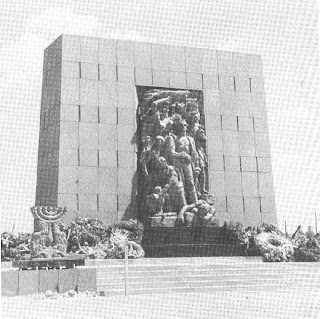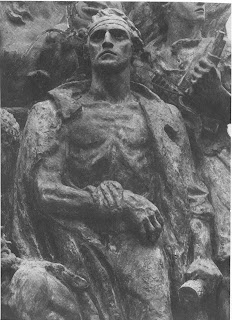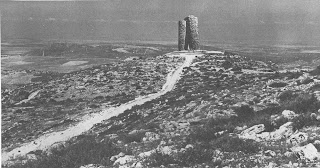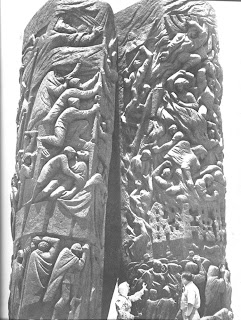
I'd never heard of Nathan Rapoport until last week,
but I first saw his sculpture about 25 years ago,
since the Park Avenue Synagogue is located between my grandmother's apartment
on 88th at Lexington
-- and the Metropolitan Museum on Fifth Ave at 82nd.
This facade dedicated to Janusz Korczak, ''The King of Children'', was
something of an anomaly when it was made in 1980,
since figure sculpture had been banished from architecture for
at least 30 years by that time
(and it had been banished from Jewish temples forever)

It had design -- it had drama,
it had a kind of sweet dreaminess.
It was doing its job.

And now I've learned that the sculptor's career
goes back to this piece dedicated in 1948
to the fighters of the Warsaw Ghetto uprising.
I can't find a bio for Rapoport on the web -- so all I've got is an the introductory essay written by a journalist, Richard Yaffe. We're told about his grandfathers (both Chassidim - a cantor and butcher) but what about his parents ? We're told he went to the Warsaw Academy of Art -- but how long was he there ? He was 28 when Poland was invaded, and the story is told that he set out on foot to find and join the Polish army, but for some curious reason, he took a portofolio of his work with him -- which he showed to Soviet authorities, some of whom, from the Minsk Art Commission, invited him to Minsk -- where he must have joined the Artist's Union because
he worked on a monument to Stalin (who else ?) with Abram Brazer (1892-1942)
There, he attracted the attention of a miltary official, Kulagin (first name ?), who protected and patronized him throughout the war years. His first great monument was this tribute to the Warsaw Ghetto - begun in 1943, and eventually erected after the war in 1945
using "splendid Labrador granite, ordered cut originally by Arno Breker, for a monument to commemorate Hitler's victory"
Then he went to Israel, beginning with a monument to a Anilewicz, a hero of the Warsaw Ghetto - to commemorate a Kibbutz destroyed in the Egyptian war, Yad Mordechai. He went on to make other monuments in Isreal as well as Philadelphia, New York, and Toronto.
But whatever happened to his career as a Soviet sculptor ? Did he defect ? Did he become an Israeli citizen ? And whatever happened to General Kulagin ? I wish someone in his family would put up a website to answer all these questions !

Here's some details from the Warsaw monument
(which, incidentally, was reproduced in Yad Vashem, Israel)

There's that same kind of passionate idealism I found
here in the 19the C. Jewish sculptor from Baltimore (whom I'm sure Rapoport had never seen), and that sorrowful intensity of the early 20th C. sculptor
Glicenstein as well.
It's not cool Classical -- it's not detached.
But it also feels -- well -- small and broken

a little like the puffery of a cartoon character

But it does have its moments -
like this doomed hero -- and how it compares
with Arno Breker's doomed Nazi hero shown
here 
This is the monument to Anilewicz, another one of Rapoport's doomed heroes.
And isn't that best kind ?
( failure being proof of the challenge undertaken)

I look at this -- and hear the theme song from "Exodus"
swelling up in the background.
I guess you could call this "movie sculpture"

This is quite a monument, isn't it ?
It's really become part of a landscape

My friend from Iowa recognizes these as silos
(but even a half-jew like myself can see that they're giant torah scrolls!)

Look at the size of these things!
They're not boring -- but I'm not sure they will have the after-life
that ancient Assyrian reliefs, for example, have in art museums.
(in contrast to
these dramatic reliefs by another 20th C. sculptor, Emilio Greco.)


Or compare the above version of Job -- to
this one by Milton Horn.
For me the comparison is hardly fair -- since I've only seen the Horn in person --
but via photograph, Rapoport's version does seem more compelling.

Here's a detail of the relief that accompanies the Warsaw Ghetto memorial,
which kind of reminds me of
this parade by Lorado Taft
..except, of course, this march is a grim one

Here's "Jacob and the Angel" made for Toronto.
Horn did this theme very differently -- on a much smaller scale
-- and much less successfully (but I don't have a picture)
I especially like the figure of Jacob (it reminds me of my brother Eric)
but the angel is a disappointment --
Angels must be beautiful !
And other-worldly !
(
here's Rembrandt's version. )
***************************************
Overall -- the thing about Nathan Rapoport
is that I'm fascinated by what he does
even as I wish he did some things better.
..And I'm glad I finally discovered him,
and blogged about him today,
that just happens to be the annual Yom Hashoah
( Holocaust Remembrance Day)



























































